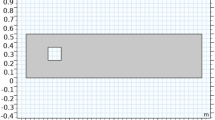Abstract
A modified version of Hammouda’s model for heat transfer in the inverted annular flow mode region is proposed, central to which is the use of temperature factor in calculating the Nusselt number and a new approximation of the influence coefficient θ. As a result, good agreement with experimental data for steam-water flow is obtained. Criteria for selecting the length integration step in computation codes are suggested.
Similar content being viewed by others
References
Yu. N. Kuznetsov, Heat Transfer in the Nuclear Reactor Safety Problem (Energoatomizdat, Moscow, 1989) [in Russian].
M. E. Nakla, D. C. Groeneveld, and S. C. Cheng, “Experimental Study of Inverted Annular Film Boiling in a Vertical Tube Cooled by R-134a,” Int. J. Multiphase Flow 37, 67 (2011).
N. Hammouda, D. C. Groeneveld, and S. C. Cheng, “Two-Fluid Modeling of Inverted Annular Film Boiling,” Int. J. Heat and Mass Transfer 40(11), 2655 (1997).
W. M. Kays and E. V. Leunge, “Heat Transfer in Annual Passages — Hydrodynamically Developed Turbulent Flow with Developed Turbulent Flow Arbitrarily Prescribed Heat Flux,” Int. J. Heat and Mass Transfer 6(7), 537 (1963).
B. S. Petukhov, Heat Transfer and Pressure Drop during Laminar Flow in Tubes (Energiya, Moscow, 1967) [in Russian].
Y. Chen, “Heat Transfer in Film Boiling of Flowing Water,” in Proceedings of InTech “Theoretical Analysis, Experimental Investigations and Industrial Systems,” 2011, pp. 235–260.
Yu. G. Dragunov, M. A. Bykov, V. A. Vasilenko, and Yu. A. Migrov, “Experience with Introduction and Development of the KORSAR Computer Code for Substantiating the Safety of NPSs with Type VVER Reactors,” Therm. Eng., No. 1, 43 (2006).
Yu. A. Bezrukov and V. I. Shchekoldin, “Verifying the Burnout and Post-Burnout Heat-Transfer Calculation Models Incorporated in the KORSAR Computer Code,” Therm. Eng., No. 11, 937 (2002).
A. A. Veremeev, A. A. Ivashkevich, I. P. Smogalev, et al., “Verifying the Post-Burnout Heat-Transfer Model of the Thermohydraulic Code KORSAR,” Therm. Eng., No. 11, 948 (2002).
A. Lapperiere and D.C. Groeneveld, “A Study of Low Quality Film Boiling at High Pressures and Flows,” AIChE Symp. Series 236 80, 440–445 (1984).
J. C. Stewart and D.C. Groeneveld, “Low Quality and Subcooled Film Boiling at Elevated Pressure,” Nucl. Eng. Design 67, 254 (1982).
N. T. Obot and M. Ishii, “Two-Phase Flow Regime Transition Criteria in Post Dryout Region Based on Flow Visualization Experiments,” Int. J. Heat and Mass Transfer 31(12) 2559 (1988).
N. Hammouda and D. C. Groeneveld, “An Experimental Study of Subcooled Film Boiling of Rerigerants in Vertical Up-Flow,” Int. J. Heat and Mass Transfer 39(18), 3799 (1996).
Author information
Authors and Affiliations
Additional information
Original Russian Text © N.D. Agafonova, I.L. Paramonova, 2013, published in Teploenergetika.
Rights and permissions
About this article
Cite this article
Agafonova, N.D., Paramonova, I.L. Heat transfer in inverted annular mode of steam-water flow. Therm. Eng. 60, 176–181 (2013). https://doi.org/10.1134/S0040601513030014
Published:
Issue Date:
DOI: https://doi.org/10.1134/S0040601513030014



